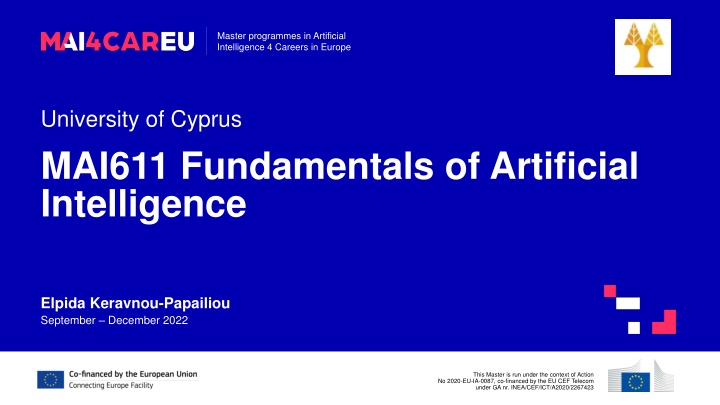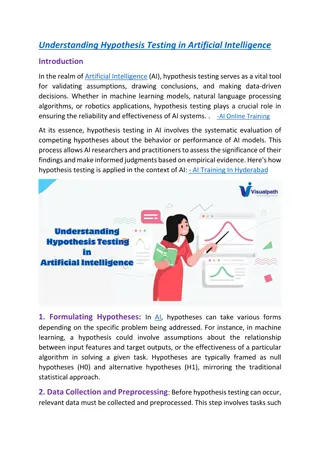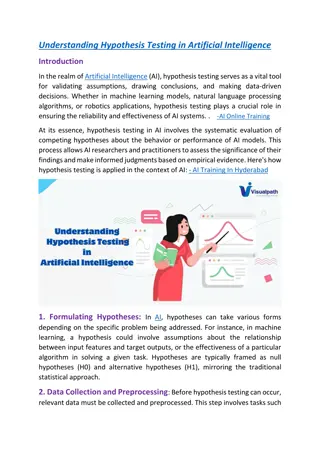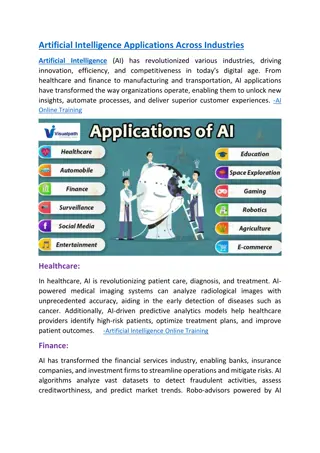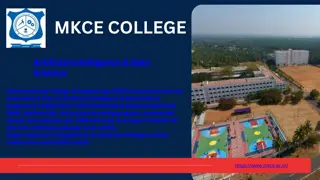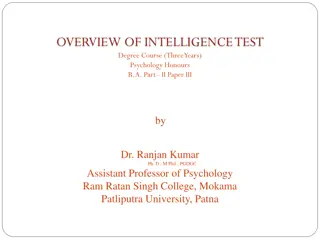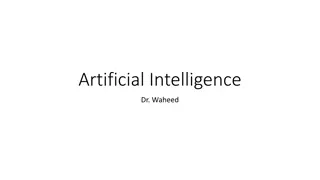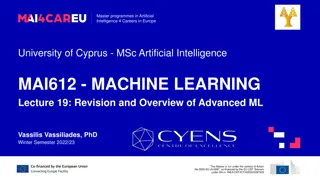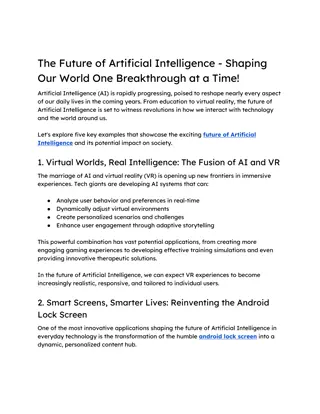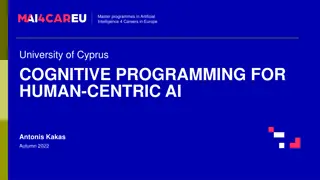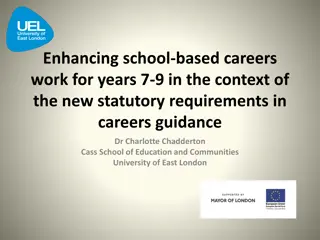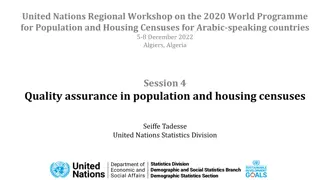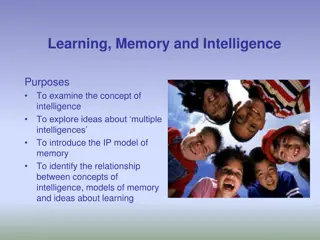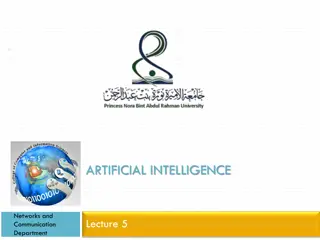Master Programmes in Artificial Intelligence for Careers in Europe
This Master program at the University of Cyprus delves into deep knowledge-based systems in artificial intelligence, covering topics such as heuristic classification, collaborative models of specialists, and generic tasks architecture. Students will gain insights into the second generation of expert systems and strategic knowledge applications. Co-financed by the EU, this program aims to equip students with cutting-edge skills for AI careers in Europe.
Download Presentation

Please find below an Image/Link to download the presentation.
The content on the website is provided AS IS for your information and personal use only. It may not be sold, licensed, or shared on other websites without obtaining consent from the author.If you encounter any issues during the download, it is possible that the publisher has removed the file from their server.
You are allowed to download the files provided on this website for personal or commercial use, subject to the condition that they are used lawfully. All files are the property of their respective owners.
The content on the website is provided AS IS for your information and personal use only. It may not be sold, licensed, or shared on other websites without obtaining consent from the author.
E N D
Presentation Transcript
Master programmes in Artificial Intelligence 4 Careers in Europe University of Cyprus MAI611 Fundamentals of Artificial Intelligence Elpida Keravnou-Papailiou September December 2022 This Master is run under the context of Action No 2020-EU-IA-0087, co-financed by the EU CEF Telecom under GA nr. INEA/CEF/ICT/A2020/2267423
Master programmes in Artificial Intelligence 4 Careers in Europe Deep Knowledge-Based Systems: the second generation of expert systems This Master is run under the context of Action No 2020-EU-IA-0087, co-financed by the EU CEF Telecom under GA nr. INEA/CEF/ICT/A2020/2267423
Master programmes in Artificial Intelligence 4 Careers in Europe UNIT 8 Deep Knowledge-Based Systems: the second generation of expert systems CONTENTS 1. The notion of deepness with respect to knowledge-based systems 2. NEOMYCIN: Multi-modelling, strategic explanations 3. Heuristic Classification 4. MDX: Community of collaborating specialists, new meaning of Compiled Knowledge 5. Generic Tasks Architecture This Master is run under the context of Action No 2020-EU-IA-0087, co-financed by the EU CEF Telecom under GA nr. INEA/CEF/ICT/A2020/2267423 3
Master programmes in Artificial Intelligence 4 Careers in Europe INTENDED LEARNING OUTCOMES Upon completion of this unit on deep knowledge-based systems: the second generation of expert systems, students will be able: 1. To explain the notion of deepness with respect to knowledge-based systems, particularly the second generation of expert system. 2. To discuss the distinguishing features of the second generation of expert systems. 3. To discuss the use of multiple models (structural knowledge and support knowledge) in NEOMYCIN, as well as the representation and interpretation of strategic knowledge in this system, and the production and semantics of strategic explanations. 4. To explain the generic problem-solving method of heuristic classification. 5. To present an alternative meaning of the notion of compiled knowledge and to compare it with MYCIN s proposition. 6. To explain the collaborative model of specialists and the distributive architecture of MDX, and its auxiliary subsystems. 7. To present the generic tasks architecture and to analyze the notion of reusability with respect to deep knowledge- based systems. This Master is run under the context of Action No 2020-EU-IA-0087, co-financed by the EU CEF Telecom under GA nr. INEA/CEF/ICT/A2020/2267423 4
Master programmes in Artificial Intelligence 4 Careers in Europe The notion of deepness with respect to knowledge-based systems This Master is run under the context of Action No 2020-EU-IA-0087, co-financed by the EU CEF Telecom under GA nr. INEA/CEF/ICT/A2020/2267423
Master programmes in Artificial Intelligence 4 Careers in Europe Deep vs Shallow Early knowledge-based (expert) systems were characterized as shallow, aiming for the second-generation to be characterized as deep systems Deepness/shallowness are relative (not absolute), multi-dimensional notions encompassing: Human-Computer Interaction Problem-Solving Flexibility Extensibility All dimensions must be analyzed wholistically to reveal the root causes of the limitations This Master is run under the context of Action No 2020-EU-IA-0087, co-financed by the EU CEF Telecom under GA nr. INEA/CEF/ICT/A2020/2267423 6
Master programmes in Artificial Intelligence 4 Careers in Europe Deepness of human specialized knowledge/expertise Human specialists can deal with exceptional cases, not just routinely occurring cases flexibility They refer clients to other specialists when a client s case is outside their own expertise self-reflection on limits of their knowledge/expertise They continuously upgrade (revise) their knowledge/expertise, both through their own experience as well as from the literature or reports of other experts - learning This Master is run under the context of Action No 2020-EU-IA-0087, co-financed by the EU CEF Telecom under GA nr. INEA/CEF/ICT/A2020/2267423 7
Master programmes in Artificial Intelligence 4 Careers in Europe Limitations regarding Problem-solving flexibility Monolithic, rigidly-applied reasoning Inability to dynamically plan its reasoning strategy for a specific case, based on the characteristics of the case Alternative, orthogonal strategies not supported Performance degrades dramatically when dealing with difficult (rare) cases Inability to recognize that a problem case is at the periphery or outside of its area of expertise This Master is run under the context of Action No 2020-EU-IA-0087, co-financed by the EU CEF Telecom under GA nr. INEA/CEF/ICT/A2020/2267423 8
Master programmes in Artificial Intelligence 4 Careers in Europe Limitations regarding Human-computer interaction Inadequate user interface Information required to be entered in very specific terminologies and formats Historic information on a case not maintained Inadequate dialogue structure System raises incoherent or redundant questions User not allowed to volunteer information or focusing guidance User not allowed to revoke an answer, or to pursue the effects of an alternative answer (to see what if . . . . ) Inadequate explanation structure Explanations are just rule playbacks, and not meaningful Explanations by and large are not user-tailored and do not cover all the explanation needs of the user This Master is run under the context of Action No 2020-EU-IA-0087, co-financed by the EU CEF Telecom under GA nr. INEA/CEF/ICT/A2020/2267423 9
Master programmes in Artificial Intelligence 4 Careers in Europe Limitations regarding Extensibility (maintainability) Difficult to modify the system knowledge, both manually and automatically; consistency checks not facilitated Inability of the system to evolve based on its experiences in problem solving This Master is run under the context of Action No 2020-EU-IA-0087, co-financed by the EU CEF Telecom under GA nr. INEA/CEF/ICT/A2020/2267423 10
Master programmes in Artificial Intelligence 4 Careers in Europe Cause of Limitations The cause of the serious limitations of the first generation of knowledge-based (expert) systems was attributed to the fact that important knowledge was completely absent or appeared in an implicit way. Specifically, three types of knowledge did not appear explicitly: 'How' Knowledge control or strategic knowledge 'What' Knowledge descriptive functional knowledge 'Why' Knowledge justification knowledge or causal knowledge This Master is run under the context of Action No 2020-EU-IA-0087, co-financed by the EU CEF Telecom under GA nr. INEA/CEF/ICT/A2020/2267423 11
Master programmes in Artificial Intelligence 4 Careers in Europe Main Distinguishing Features of Second Generation The use of multiple models and corresponding reasoning mechanisms. There are usually two models: The heuristic model Some 'deeper' model, mainly a causal model Knowledge Level Design demonstrating higher abstraction in how to solve relevant problems more rational way of development Greater emphasis on the ability of the system to learn and self-improve, where for example the heuristic model can be gradually generated from the 'deeper' model, in a (semi)automatic way This Master is run under the context of Action No 2020-EU-IA-0087, co-financed by the EU CEF Telecom under GA nr. INEA/CEF/ICT/A2020/2267423 12
Master programmes in Artificial Intelligence 4 Careers in Europe Reusability In the first generation, it was purely at the representation or implementation level: It was manifested through the concept of the system shell which involved the reuse of the symbolic way of representing knowledge as well as the code of the corresponding reasoning mechanism The second generation provides new interpretations for reusability, mainly at the level of knowledge: reuse of conceptual knowledge models reuse of knowledge bases or symbolic units, i.e., code Reusable modules (conceptual or symbolic) are not necessarily complete views of a system, as is the case with system shells, but are simply building blocks that need to be composed to produce the complete view of the system This Master is run under the context of Action No 2020-EU-IA-0087, co-financed by the EU CEF Telecom under GA nr. INEA/CEF/ICT/A2020/2267423 13
Master programmes in Artificial Intelligence 4 Careers in Europe NEOMYCIN: multi-modelling, strategic explanations This Master is run under the context of Action No 2020-EU-IA-0087, co-financed by the EU CEF Telecom under GA nr. INEA/CEF/ICT/A2020/2267423
Master programmes in Artificial Intelligence 4 Careers in Europe NEOMYCIN The NEOMYCIN system is the 'reconstruction' of MYCIN It was also developed at Stanford University, with William J. Clancey as principal investigator Key motivation behind the creation of NEOMYCIN The various shortcomings and inherent problems of GUIDON, MYCIN's teaching system GUIDON's failure lay in the fact that MYCIN's reasoning, in other words the backwards chaining of rules, which GUIDON was trying to teach, did not match human reasoning This Master is run under the context of Action No 2020-EU-IA-0087, co-financed by the EU CEF Telecom under GA nr. INEA/CEF/ICT/A2020/2267423 15
Master programmes in Artificial Intelligence 4 Careers in Europe Central system goal The explicit modelling of strategic knowledge as a basic precondition for the effective teaching of diagnostic reasoning and the accurate interpretation of a student's behaviour during problem solving. In addition, the scope of the knowledge base was expanded beyond microbiological infections of the blood by the addition of other categories of infections. This Master is run under the context of Action No 2020-EU-IA-0087, co-financed by the EU CEF Telecom under GA nr. INEA/CEF/ICT/A2020/2267423 16
Master programmes in Artificial Intelligence 4 Careers in Europe NEOMYCIN s Knowledge Base Knowledge about infections is described in two different ways: Taxonomic Model structural knowledge Causal Model support knowledge The taxonomic model is considered the heuristic model and the causal model the 'deep' model. This Master is run under the context of Action No 2020-EU-IA-0087, co-financed by the EU CEF Telecom under GA nr. INEA/CEF/ICT/A2020/2267423 17
NEOMYCINs Descriptive Knowledge Models Taxonomic Model (Structural knowledge) rules attached to frames triggering link Causal Model (support knowledge) causal link (caused-by) This Master is run under the context of Action No 2020-EU-IA-0087, co-financed by the EU CEF Telecom under GA nr. INEA/CEF/ICT/A2020/2267423 18
Master programmes in Artificial Intelligence 4 Careers in Europe Taxonomic Model Representation Each node of the taxonomy is a frame, which among others contains all the rules related to the given disease or class of diseases. Taxonomic Model Reasoning The 'hypothesize and refine' strategy is applied By using triggers, the initial goal is to activate an intermediate node of the taxonomy and from there gradually select successor nodes (subcategories) until a terminal node (individual disease) is selected. "trigger" example: "headache along with neck stiffness triggers the meningitis hypothesis" This Master is run under the context of Action No 2020-EU-IA-0087, co-financed by the EU CEF Telecom under GA nr. INEA/CEF/ICT/A2020/2267423 19
Master programmes in Artificial Intelligence 4 Careers in Europe Causal Model It depicts the given knowledge at a deeper level The relationship that connects the nodes in the various causal chains is 'may-be- caused-by' Therefore, chains are abductive in form (from indications to causes, backwards in time), in contrast to taxonomic paths which are deductive in form Some nodes in the causal chains also belong to the taxonomic model, not necessarily as terminal nodes These nodes are the connecting links between the two models This Master is run under the context of Action No 2020-EU-IA-0087, co-financed by the EU CEF Telecom under GA nr. INEA/CEF/ICT/A2020/2267423 20
Master programmes in Artificial Intelligence 4 Careers in Europe Alternative Problem-Solving Strategies The taxonomic model provides a more efficient way to solve problems. The causal model leads to a more thorough and detailed search for the solution. This strategy is expected to be useful in relation to difficult problems that are not adequately covered by the abstract rules of taxonomy nodes. The main use of the causal model is to justify, at a deeper level, the solutions produced through the taxonomic model, where the two models are applied in a purely collaborative manner. This Master is run under the context of Action No 2020-EU-IA-0087, co-financed by the EU CEF Telecom under GA nr. INEA/CEF/ICT/A2020/2267423 21
Modelling Strategic Knowledge Achieving a Diagnosis 384 global task meta-rule Problem Identification Creation of Hypotheses Space Process Hard Data 385 428 (sub)task 427 Initial Inform. Chief Complain Explore & Refine Review Conflict Set Group & Differentiate Linking tasks to subtasks via meta-rules Part of NEOMYCIN s Task Taxonomy 22 This Master is run under the context of Action No 2020-EU-IA-0087, co-financed by the EU CEF Telecom under GA nr. INEA/CEF/ICT/A2020/2267423
Master programmes in Artificial Intelligence 4 Careers in Europe Meta-rules The various strategies regarding the execution of tasks, which result in the involvement of other (sub)tasks, are expressed in a purely declarative way in the form of meta-rules. The premise of a meta-rule states the conditions governing the use of that strategy, while its action states the subtask or sequence of subtasks involved. Reasoning knowledge is expressed in an abstract way, that is, a way independent of the knowledge domain. Meta-rules refer to abstract concepts such as 'indication' and cause' rather than specific concepts such as 'headache' and 'meningitis'. This Master is run under the context of Action No 2020-EU-IA-0087, co-financed by the EU CEF Telecom under GA nr. INEA/CEF/ICT/A2020/2267423 23
Example Tasks and Meta-rules Task: Group & Differentiate Meta-rule: If there are two elements in the conflict set, which differ on some characteristic pose a question to the user in relation to that characteristic Then This Master is run under the context of Action No 2020-EU-IA-0087, co-financed by the EU CEF Telecom under GA nr. INEA/CEF/ICT/A2020/2267423 24
Task: Test Hypothesis Meta-rule: If the element under question is closely related to the hypothesis apply the relevant rules with the goal of answering the question Then Meta-rule: If the element under question will result in increasing the credibility of the hypothesis apply the relevant rules with the goal of answering the question Then This Master is run under the context of Action No 2020-EU-IA-0087, co-financed by the EU CEF Telecom under GA nr. INEA/CEF/ICT/A2020/2267423 25
Task: Explore & Refine Meta-rule: If the explored hypothesis has some refinement that has not been explored yet the refinement should be explored Then Task: Characterize Data Meta-rule: If there is some unknown information in relation with the most recent datum then this information should be explored Then This Master is run under the context of Action No 2020-EU-IA-0087, co-financed by the EU CEF Telecom under GA nr. INEA/CEF/ICT/A2020/2267423 26
Task: Exploring Meta-rule: If the desired information is a subcategory of some category that has been excluded draw the conclusion that the information is not valid Then This Master is run under the context of Action No 2020-EU-IA-0087, co-financed by the EU CEF Telecom under GA nr. INEA/CEF/ICT/A2020/2267423 27
Master programmes in Artificial Intelligence 4 Careers in Europe Task Interpreter The meta-rules of the task under execution are interpreted based on forward chaining. The rules are arranged in a given order. Usually, the action of the last rule is that the execution of the task is complete, that is, its premise states the termination condition. The premises of the rules are successively examined, each time starting from the beginning of the sequence of rules, and the first rule in the sequence whose premise is verified is applied, until either the last rule is verified, or some rule that expressly states the termination of the execution of the task is verified. This Master is run under the context of Action No 2020-EU-IA-0087, co-financed by the EU CEF Telecom under GA nr. INEA/CEF/ICT/A2020/2267423 28
Achieving a Diagnosis Problem Process Hard Data Task Identification Creation of Hypotheses Space rule-1 rule-2 . . . rule-n Initial Info. Complain Chief G & D E & R General Quest. Process Data Process Data Explore neurosign headache subtask-1 . . . subtask-m infection Q . . . Q Process Data febrile Q . . . Q Meta-rule interpretation Q: Question Inference Tree This Master is run under the context of Action No 2020-EU-IA-0087, co-financed by the EU CEF Telecom under GA nr. INEA/CEF/ICT/A2020/2267423 29
Master programmes in Artificial Intelligence 4 Careers in Europe Strategic Explanations The inference tree records all the reasoning of the system in the context of a given consultative conversation The way of representing and interpreting strategic knowledge allows the system to provide the user with strategic explanations: at a specific level (applying strategies in specific situations) as well at an abstract level (general strategies) As in MYCIN, there are two types of explanations, 'Why?' explanations and 'How?' explanations. This Master is run under the context of Action No 2020-EU-IA-0087, co-financed by the EU CEF Telecom under GA nr. INEA/CEF/ICT/A2020/2267423 30
Master programmes in Artificial Intelligence 4 Careers in Europe Strategic Explanations Strategic WHY Explanations Strategic HOW explanations A 'Why?' type question from the user refers to a specific task and means 'Why was it decided to perform this task? A 'How?' type question also refers to a specific task and means 'How was this task accomplished? The decision rationale is provided by the meta-rule which represents the reasoning strategy linking the two tasks in the specific contexts and more precisely the premise of the meta-rule. Such queries concern non-terminal tasks (in the inference tree). The explanation consists of the (instantiations of) sub-tasks that had to be involved based on the interpretation of the meta-rules for that task, in other words the actions of the meta-rules that have been applied. This Master is run under the context of Action No 2020-EU-IA-0087, co-financed by the EU CEF Telecom under GA nr. INEA/CEF/ICT/A2020/2267423 31
Why was the decision to execute a specific subtask taken? Strategic Why? Explanations task meta-rule subtask The subtask justification is given by the premise of the meta-rule. Example Explore and Refine (meningitis) Explore Hypothesis (bacterial-meningitis) Why? If the explored hypothesis has some refinement that has not been explored yet the refinement should be explored Then Meningitis is the explored hypothesis. Bacterial meningitis is one of its refinements that has not been explored yet. This Master is run under the context of Action No 2020-EU-IA-0087, co-financed by the EU CEF Telecom under GA nr. INEA/CEF/ICT/A2020/2267423 32
How was a specific task achieved? Strategic How? Explanations task meta-rules subtask1 subtask2 . . subtaskn The justification comes from the actions of the meta-rules. Example Explore & Refine (meningitis) How? Explore Hypothesis (bacterial meningitis) Explore Hypothesis (viral meningitis) The hypothesis of meningitis was explored and refined as follows: The hypothesis of bacterial meningitis was explored The hypothesis of viral meningitis was explored This Master is run under the context of Action No 2020-EU-IA-0087, co-financed by the EU CEF Telecom under GA nr. INEA/CEF/ICT/A2020/2267423 33
Master programmes in Artificial Intelligence 4 Careers in Europe Heuristic Classification: the generalization of NEOMYCIN s reasoning This Master is run under the context of Action No 2020-EU-IA-0087, co-financed by the EU CEF Telecom under GA nr. INEA/CEF/ICT/A2020/2267423
Master programmes in Artificial Intelligence 4 Careers in Europe Heuristic Classification For its application, three basic knowledge structures are needed: the data taxonomy, the taxonomy of solutions (solution taxonomy) and the heuristic links which connect nodes of the data taxonomy to nodes of the solution taxonomy and therefore constitute the connecting links between the two taxonomies The heuristic classification method has been incorporated into the generalized system HERACLES This Master is run under the context of Action No 2020-EU-IA-0087, co-financed by the EU CEF Telecom under GA nr. INEA/CEF/ICT/A2020/2267423 35
Heuristic Classification activation of heuristic links data abstraction heuristic link solution refinement data taxonomy solution taxonomy This Master is run under the context of Action No 2020-EU-IA-0087, co-financed by the EU CEF Telecom under GA nr. INEA/CEF/ICT/A2020/2267423 36
Master programmes in Artificial Intelligence 4 Careers in Europe Reasoning Processes: Data Abstraction It is applied to the data taxonomy, aiming to produce more abstract data from the original, very specific data of a problem. Types of Data Abstraction Qualitative abstraction, where quantitative expressions, e.g., 'temperature 41 C', are translated into qualitative expressions, e.g., 'High fever' The goal is to gradually activate nodes at higher levels of the data taxonomy. Generalization abstraction, where a specific expression, e.g., 'Augmentin administration', translates to category level, e.g., 'administration of antibiotic' Definitional abstraction, where a given datum that belongs to a conceptual category is translated into its 'equal' in another, non-hierarchically related, conceptual category, e.g., 'generalized platyspondyly' can be translated as 'short trunk' This Master is run under the context of Action No 2020-EU-IA-0087, co-financed by the EU CEF Telecom under GA nr. INEA/CEF/ICT/A2020/2267423 37
Master programmes in Artificial Intelligence 4 Careers in Europe Temporal Data Abstraction The above types of data abstraction do not use the time dimension. Types of Temporal Data Abstraction Merge abstraction, where a series of concatenable (time-point based) data are abstracted to a single time-interval based datum Recently, temporal data abstraction has attracted great research interest, where the raw data are time series of various forms, and the goal is the production of temporal abstractions such as trends and periodic events. Persistence abstraction, where a maximal interval spanning the extent of some property is derived (backwards and/or forwards in time) Trend abstraction, where the aim is to derive the significant changes and the rates of change in the progression of some parameter Periodic abstraction, where repetitive occurrences with some regularity in the pattern of repetition, are derived, e.g., headache every morning, for a week, with increasing severity This Master is run under the context of Action No 2020-EU-IA-0087, co-financed by the EU CEF Telecom under GA nr. INEA/CEF/ICT/A2020/2267423 38
Master programmes in Artificial Intelligence 4 Careers in Europe Heuristic Classification: Further Reasoning Processes Activation of Heuristic Links Solution Refinement Operates on the solution taxonomy This is a relatively simple, but critical process. In contrast to the data abstraction process which starts from low-level nodes and moves up the relative taxonomy, the process of solution refinement starts from high-level nodes and aims to move downwards Its purpose is to direct attention to nodes of the solution taxonomy since the ultimate goal is to select terminal nodes in this taxonomy. That is, starting from the nodes that the heuristic links led to, it gradually moves towards terminal nodes This Master is run under the context of Action No 2020-EU-IA-0087, co-financed by the EU CEF Telecom under GA nr. INEA/CEF/ICT/A2020/2267423 39
Master programmes in Artificial Intelligence 4 Careers in Europe MDX: Community of collaborating specialists, new meaning of compiled knowledge This Master is run under the context of Action No 2020-EU-IA-0087, co-financed by the EU CEF Telecom under GA nr. INEA/CEF/ICT/A2020/2267423
Master programmes in Artificial Intelligence 4 Careers in Europe MDX System The MDX system was developed at The Ohio State University with B. Chandrasekaran and S. Mittal as the principal investigators. The aim of the system is to diagnose the syndrome of the liver, known as cholestasis. This Master is run under the context of Action No 2020-EU-IA-0087, co-financed by the EU CEF Telecom under GA nr. INEA/CEF/ICT/A2020/2267423 41
Compiled Knowledge Alternative Definition Compiled Shallow K. Deep K. Knowledge Experiential Base of patterns Task dependent Not helpful Helpful Fundamental Principles Task independent It depends on the task Very helpful It can handle any problem that can be solved through deep knowledge, But the solution is done in a much more efficient way This Master is run under the context of Action No 2020-EU-IA-0087, co-financed by the EU CEF Telecom under GA nr. INEA/CEF/ICT/A2020/2267423 42
Master programmes in Artificial Intelligence 4 Careers in Europe Compiled Knowledge Deep knowledge is comprehensive but not operational, while shallow knowledge is operational in terms of the needs of the given task but usually has deficiencies, mainly in terms of the more difficult problems that concern it. Analogy with Compiled Programs This interpretation of compilation is compatible with the concept of program compilation where the object code is (logically) identical to the source code in terms of the set of problems that can be solved, but the object code is more efficient in terms of execution time. Compiled knowledge has the positive characteristics of the other two, the comprehensiveness of deep knowledge and the functionality of shallow knowledge. This Master is run under the context of Action No 2020-EU-IA-0087, co-financed by the EU CEF Telecom under GA nr. INEA/CEF/ICT/A2020/2267423 43
Compiled Knowledge MDX Interpretation It is the transformation of deep knowledge, into operational form, from the perspective of a given task, without reducing the comprehensiveness of the knowledge. This means that any problem that falls under the scope of the given task and can be solved through the deep knowledge, it can also be solved through the compiled knowledge, but the solution is achieved much more efficiently. The same body of deep knowledge can have multiple compilations from the perspective of different tasks. This Master is run under the context of Action No 2020-EU-IA-0087, co-financed by the EU CEF Telecom under GA nr. INEA/CEF/ICT/A2020/2267423 44
Master programmes in Artificial Intelligence 4 Careers in Europe Collaboration of Specialists The MDX system consists of three separate units: The main unit, the diagnostician, also called MDX The data manager, PATREC The radiologist, RADEX This Master is run under the context of Action No 2020-EU-IA-0087, co-financed by the EU CEF Telecom under GA nr. INEA/CEF/ICT/A2020/2267423 45
Collaboration of Specialists MDX Diagnostician RADEX Radiologist PATREC Data Manager This Master is run under the context of Action No 2020-EU-IA-0087, co-financed by the EU CEF Telecom under GA nr. INEA/CEF/ICT/A2020/2267423 46
Master programmes in Artificial Intelligence 4 Careers in Europe Each system is a community of specialists Internally, each of these systems consists of a community of specialists, who are organized in a hierarchical manner and cooperate based on a specific protocol. Each specialist is considered an autonomous entity with its own knowledge and control/reasoning mechanism, which can perform a specific task in the entire solution plan. This Master is run under the context of Action No 2020-EU-IA-0087, co-financed by the EU CEF Telecom under GA nr. INEA/CEF/ICT/A2020/2267423 47
Part of the Hierarchy of Specialists of the Diagnostician Internist Cholestasis Verification Knowledge: Extra-hep Intra-hep - Confirmation rules - Refutation rules Refinement Knowledge Inflammation Physical Activation of specialists at lower levels Cholangitis Sci-Cholangitis This Master is run under the context of Action No 2020-EU-IA-0087, co-financed by the EU CEF Telecom under GA nr. INEA/CEF/ICT/A2020/2267423 48
Master programmes in Artificial Intelligence 4 Careers in Europe Collaboration Protocol First, the problem is referred to one of the specialists, usually the one who is the most senior in the hierarchy. If a specialist decides that the problem is outside its specialty, it should refer it back to the referring specialist along with relevant guidelines. The collaboration protocol is a satisfactory simulation of reality, where the patient initially visits his physician and from there, he can be referred to various specialists and sub-specialists for a more accurate diagnosis of the causes of his problem. Each specialist should be able to decide whether the problem referred to it really belongs to its specialty. If so: In the case of a non-terminal specialist, it will then have to decide to which subordinate, not necessarily his immediate subordinate, to refer the problem to. The distributed way of organizing knowledge and reasoning is the compilation of the corresponding deep knowledge, aiming for its efficient use. In the case of a terminal specialist, it should try to solve the problem and then inform its superior. This Master is run under the context of Action No 2020-EU-IA-0087, co-financed by the EU CEF Telecom under GA nr. INEA/CEF/ICT/A2020/2267423 49
Master programmes in Artificial Intelligence 4 Careers in Europe Multi-modeling in MDX In MDX there are no alternative models for the same body of knowledge as in NEOMYCIN. Here the whole body of knowledge is divided into three separate models, one for diagnostic concepts, one for medical data concepts, and one for radiology concepts. These concepts constitute the individual specialists for each of these models. This Master is run under the context of Action No 2020-EU-IA-0087, co-financed by the EU CEF Telecom under GA nr. INEA/CEF/ICT/A2020/2267423 50
